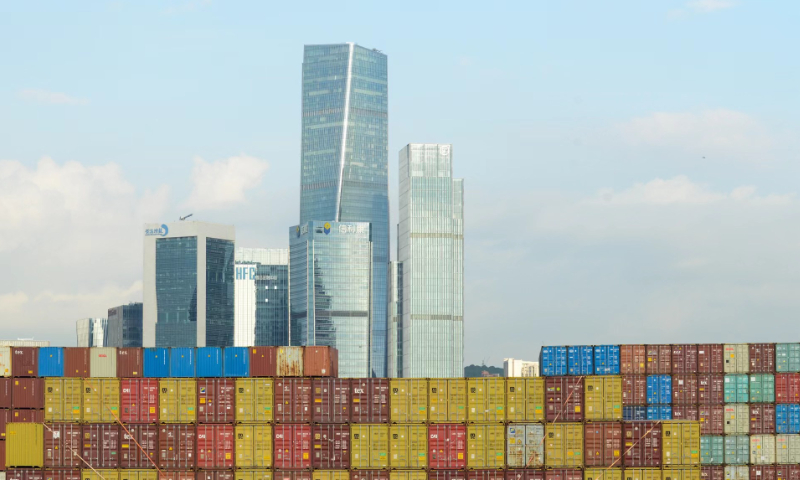
Shenzhen Qianhai Comprehensive Bonded Zone in South China's Guangdong Province on December 15, 2023 Photo: Chen Tao/GT
China's economic powerhouses, including Shanghai and South China's Guangdong Province, released their "report cards" for 2023 and their respective goals for GDP growth in 2024 on Tuesday, showcasing significant progress in industrial upgrading and an increase in foreign investment.
Shanghai set a new record in actual foreign investment utilization in 2023, while Guangdong's GDP surpassed 13 trillion yuan ($1.83 trillion), almost reaching the scale of Brazil in 2022. These figures highlight the strength and vitality of the Chinese economic giants, which are expected to lead the revival of the world's second-largest economy in 2024, experts said.
Shanghai's GDP expanded by 5 percent year-on-year in 2023 and the city saw the actual use of foreign capital hit a record high of $24 billion as it remained the top choice for multinational enterprises, Shanghai Mayor Gong Zheng announced in the city's government work report on Tuesday.
Shanghai also attracted another 65 regional headquarters of multinationals and 30 more foreign-funded research and development centers in 2023.
New growth drivers and strategic emerging industries developed steadily in Shanghai. The scale of three leading industries - integrated circuits, biopharmaceuticals and artificial intelligence (AI) - reached 1.6 trillion yuan. The cumulative number of new-energy vehicles (NEVs) in Shanghai reached 1.288 million, ranking first among global cities. The number of high-tech enterprises in Shanghai now exceeds 24,000.
The GDP of Guangdong Province grew by 4.8 percent year-on-year to 13.57 trillion yuan in 2023, topping the country for the 35th consecutive year. As a manufacturing heartland and leading foreign trade player in the country, Guangdong accounted for about one-tenth of China's GDP in 2023, the Xinhua News Agency reported.
An economy of that scale brings Guangdong close to that of Brazil in 2022, which stood at $1.92 trillion, according to World Bank data.
High-tech development has been a driving force for the province, with investment in high-tech manufacturing growing by 22.2 percent year-on-year and that of advanced manufacturing increasing by 18.2 percent. With more than 71,000 large-scale industrial enterprises and more than 75,000 high-tech enterprises, Guangdong leads the nation in both categories.
East China's Jiangsu Province reported GDP growth of 5.8 percent to 12.82 trillion yuan. East China's Zhejiang Province saw its GDP expand by 6 percent in 2023 with the actual use of foreign capital up by 4.8 percent.
In 2023, the economic powerhouses made significant progress in industrial upgrading, manufacturing and foreign investment, Tian Yun, a veteran economist based in Beijing, told the Global Times on Tuesday.
"Notably, the record-high foreign capital usage in Shanghai, a leading metropolis of China's opening-up, indicates the country's overall industrial advantages and unchanging position in the global supply chain remain attractive to foreign investors," Tian said.
According to data from the Ministry of Commerce, China's foreign capital usage exceeded 1.13 trillion yuan in 2023, with sources from high-tech industries reaching a record high.
"China now is attracting capital from all over the world, not only from the Western world. So we see a lot of, for example, Middle Eastern money moving to China in a big way for diversification and to seize different opportunities," Rani Jarkas, chairman of Swiss financial firm Cedrus Group, told the Global Times in a recent interview.
It is believed that China's attractiveness to overseas capital in 2024 will be even greater than in 2023. If this trend can be sustained, it will thwart the technology decoupling intentions of certain countries, Tian said.
The economic powerhouses also announced their GDP targets for 2024 at 5-5.5 percent, leading experts to believe that the country may set its overall GDP growth target at about 5 percent.
"Economic growth in 2024 is expected to remain at about 5 percent, with a focus on investment growth," Tian said.
Based on the plans of various provinces for 2024, the economically developed provinces are focusing on strategic emerging industries and industries of the future, forming what is known as new productive forces, Hu Qimu, a deputy secretary-general of the digital-real economies integration Forum 50, told the Global Times on Tuesday.
For example, Shanghai has set a GDP growth target at about 5 percent for the year 2024. The city plans to renew efforts to enhance high-end industry clusters such as for NEVs, high-end equipment and advanced materials. It will also launch a pilot program for intelligent connected vehicle access and on-road operation, taking the lead nationally.
Guangdong also set its GDP growth target at 5 percent in 2024, with a focus on developing industries of the future such as 6G, quantum technology, life sciences and humanoid robots. It also aims to become an innovation hub for general AI industries.
Zhejiang set its 2024 growth target at 5.5 percent, pledging to vigorously develop the digital economy and add 5,000 new high-tech companies.
"If these provinces can maintain their growth while ensuring that the added value of economic growth comes mainly from the new productive forces, it means that China's economy will be achieving a structural transformation or upgrade without losing momentum," Hu said.
While the eastern provinces are leading the way and establishing growth momentum on the development of emerging strategic industries, provinces in the central and western regions are expected to take on the transfer of traditional manufacturing industries, Hu noted.
"During this transfer process, there is immense potential in terms of industrial value-added, consumption and infrastructure development," Hu said.




